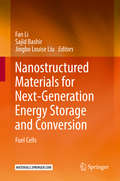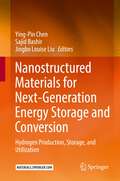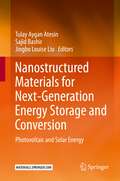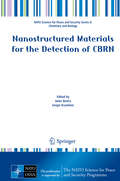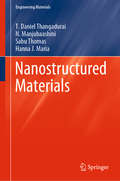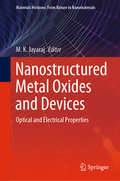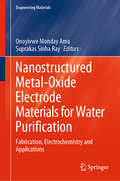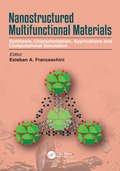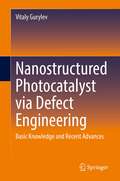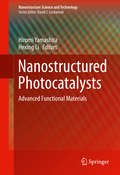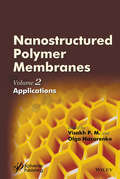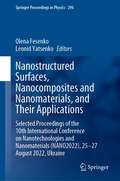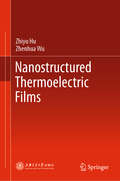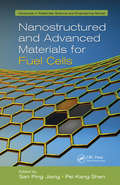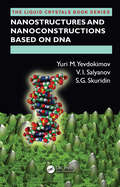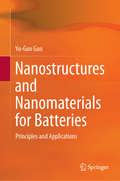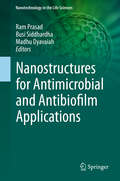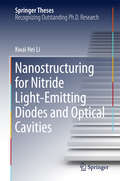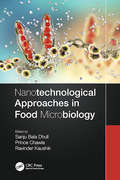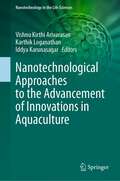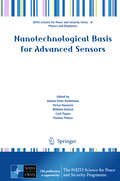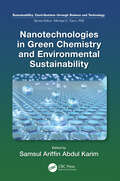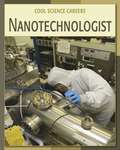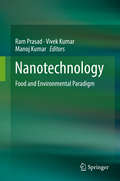- Table View
- List View
Nanostructured Materials for Next-Generation Energy Storage and Conversion: Hydrogen Production, Storage, And Utilization
by Sajid Bashir Jingbo Louise Liu Fan LiThe energy crisis and pollution have posed significant risks to the environment, transportation, and economy over the last century. Thus, green energy becomes one of the critical global technologies and the use of nanomaterials in these technologies is an important and active research area. This book series presents the progress and opportunities in green energy sustainability. Developments in nanoscaled electrocatalysts, solid oxide and proton exchange membrane fuel cells, lithium ion batteries, and photovoltaic techniques comprise the area of energy storage and conversion. Developments in carbon dioxide (CO2) capture and hydrogen (H2) storage using tunable structured materials are discussed. Design and characterization of new nanoscaled materials with controllable particle size, structure, shape, porosity and band gap to enhance next generation energy systems are also included.The technical topics covered in this series are metal organic frameworks, nanoparticles, nanocomposites, proton exchange membrane fuel cell catalysts, solid oxide fuel cell electrode design, trapping of carbon dioxide, and hydrogen gas storage.
Nanostructured Materials for Next-Generation Energy Storage and Conversion: Hydrogen Production, Storage, and Utilization
by Ying-Pin Chen Sajid Bashir Jingbo Louise LiuVolume 1 of a 4-volume series is a concise, authoritative and an eminently readable and enjoyable experience related to hydrogen production, storage and usage for portable and stationary power. Although the major focus is on hydrogen, discussion of fossil fuels and nuclear power is also presented where appropriate. This monograph is written by recognized experts in the field, and is both timely and appropriate as this decade will see application of hydrogen as an energy carrier, for example in transportation sector. The world's reliance on fossil fuels is due to the ever growing need for energy to sustain life and on-going progress; however exploitation also brings consequences such as emission of carbon, nitrogen and sulfur dioxides into the atmosphere. The collective influence of these photochemical gases is production of acid rain and an alternation of global temperatures, leading to record high temperatures in many parts of the world. The fossil fuel is unsustainable and thus there is a critical need for alternative sustainable energy resources. One universal energy carrier is hydrogen, which is the focus of this volume. This book is suitable for those who work in the energy field as technical experts, including engineers and scientists, as well as managers, policy and decision-makers, environmentalists and consultants. Students and practitioners such as lectures, teachers, legislators and their aids in the field of energy will find this book invaluable and a practical handbook or guide in the field of sustainable energy with emphasis on hydrogen as an energy carrier.
Nanostructured Materials for Next-Generation Energy Storage and Conversion: Photovoltaic and Solar Energy
by Sajid Bashir Jingbo Louise Liu Tulay Aygan AtesinNanostructured Materials for Next-Generation Energy Storage and Conversion: Photovoltaic and Solar Energy, is volume 4 of a 4-volume series on sustainable energy. Photovoltaic and Solar Energy while being a comprehensive reference work, is written with minimal jargon related to various aspects of solar energy and energy policies. It is authored by leading experts in the field, and lays out theory, practice, and simulation studies related to solar energy and allied applications including policy, economic and technological challenges. Topics covered include: introduction to solar energy, fundamentals of solar radiation, heat transfer, thermal collection and conversion, solar economy, heating, cooling, dehumidification systems, power and process heat, solar power conversion, policy and applications pertinent to solar energy as viable alternatives to fossil fuels. The aim of the book is to present all the information necessary for the design and analysis of solar energy systems for engineers, material scientists, economics, policy analysts, graduate students, senior undergraduates, solar energy practitioner, as well as policy or lawmakers in the field of energy policy, international energy trade, and libraries which house technical handbooks related to energy, energy policy and applications.
Nanostructured Materials for the Detection of CBRN (NATO Science for Peace and Security Series A: Chemistry and Biology)
by Janez Bonča Sergei KruchininThis book includes topics in nanophysics, nanotechnology, nanomaterials, sensors, biosensors, security systems, and CBRN agents detection. There have been many significant advances in the past two years and some entirely new directions of research are just opening up. Recent developments in nanotechnology and measurement techniques now allow experimental investigation of the physical properties of nanostructured materials. The book presents new methods for the detection of chemical, biological, radiological and nuclear (CBRN) agents using chemical and biochemical sensors. Identification, protection and decontamination are the main scientific and technological responses for the modern challenges of CBRN agents.
Nanostructured Materials: Synthesis, Properties, And Advanced Applications (Engineering Materials)
by Sabu Thomas T. Daniel Thangadurai N. Manjubaashini Hanna J. MariaThis book discusses the early stages of the development of nanostructures, including synthesis techniques, growth mechanisms, the physics and chemistry of nanostructured materials, various innovative characterization techniques, the need for functionalization and different functionalization methods as well as the various properties of nanostructured materials. It focuses on the applications of nanostructured materials, such as mechanical applications, nanoelectronics and microelectronic devices, nano-optics, nanophotonics and nano-optoelectronics, as well as piezoelectric, agriculture, biomedical and, environmental remediation applications, and anti-microbial and antibacterial properties. Further, it includes a chapter on nanomaterial research developments, highlighting work on the life-cycle analysis of nanostructured materials and toxicity aspects.
Nanostructured Metal Oxides and Devices: Optical and Electrical Properties (Materials Horizons: From Nature to Nanomaterials)
by M. K. JayarajThis book primarily covers the fundamental science, synthesis, characterization, optoelectronic properties, and applications of metal oxide nanomaterials. It discusses the basic aspects of synthetic procedures and fabrication technologies, explains the related experimental techniques and also elaborates on the current status of nanostructured oxide materials and related devices. Two major aspects of metal oxide nanostructures – their optical and electrical properties – are described in detail. The first five chapters focus on the optical characteristics of semiconducting materials, especially metal oxides at the nanoscale. The following five chapters discuss the electrical properties observed in metal oxide-based semiconductors and the status quo of device-level developments in a variety of applications such as sensors, transistors, dilute magnetic semiconductors, and dielectric materials. The basic science and mechanism behind the optoelectronic phenomena are explained in detail, to aid readers interested in the structure–property symbiosis in semiconducting nanomaterials. In short, the book offers a valuable reference guide for researchers and academics in the areas of material science and semiconductor technology, especially nanophotonics and electronics.
Nanostructured Metal-Oxide Electrode Materials for Water Purification: Fabrication, Electrochemistry and Applications (Engineering Materials)
by Suprakas Sinha Ray Onoyivwe Monday AmaThis book reports on the development of nanostructured metal-oxide-based electrode materials for use in water purification. The removal of organic pollutants and heavy metals from wastewater is a growing environmental and societal priority. This book thus focuses primarily on new techniques to modify the nanostructural properties of various solvent-electrolyte combinations to address these issues. Water treatment is becoming more and more challenging due to the ever increasing complexity of the pollutants present, requiring alternative and complementary approaches toward the removal of toxic chemicals, heavy metals and micro-organisms, to name a few. This contributed volume cuts across the fields of electrochemistry, water science, materials science, and nanotechnology, while presenting up-to-date experimental results on the properties and synthesis of metal-oxide electrode materials, as well as their application to areas such as biosensing and photochemical removal of organic wastewater pollutants. Featuring an introductory chapter on electrochemical cells, this book is well positioned to acquaint interdisciplinary researchers to the field, while providing topical coverage of the latest techniques and methodology. It is ideal for students and research professionals in water science, materials science, and chemical and civil engineering.
Nanostructured Multifunctional Materials: Synthesis, Characterization, Applications and Computational Simulation
by Esteban A. FranceschiniThe development of nanomaterials plays a fundamental role in current and future technology applications, particularly nanomaterials that have multiple functionalities. This book provides a broad overview of the effect of nanostructuring in the multifunctionality of different widely studied nanomaterials. This book is divided into four sections constituting a road map that groups materials sharing certain types of nanostructuring, including nanoporous, nanoparticled, 2D laminar nanomaterials, and computational methods for characterizations of nanostructures. This structured approach in nanomaterials research will serve as a valuable reference material for chemists, (bio)engineers, physicists, nanotechnologists, undergraduates, and professors.
Nanostructured Photocatalyst via Defect Engineering: Basic Knowledge and Recent Advances
by Vitaly GurylevThis book helps readers comprehend the principles and fundamentals of defect engineering toward realization of an efficient photocatalyst. The volume consists of two parts, each of which addresses a particulate type of defects. The first, larger section provides a comprehensive and rigorous treatment of the behaviour and nature of intrinsic defects. The author describes how their controlled introduction and consequent manipulation over concentration, distribution, nature and diffusion is one of the most effective and practical methodologies to modify the properties and characteristics of target photocatalytic materials. The second part of the book explains the formation of extrinsic defects in the form of metallic and non-metallic dopants and gives a detailed description of their characteristics as this approach is also often used to fabricate an efficient photocatalyst. Filling the gap in knowledge on the correlation between introduction of defects in various semiconducting materials and their photocatalytic performance, the book is ideal for graduate students, academics and researchers interested in photocatalysts, defect engineering, clean energy, hydrogen production, nanoscale advanced functional materials, CO2 deactivation, and semiconductor engineering.
Nanostructured Photocatalysts
by Hiromi Yamashita Hexing LiWhile books on semiconductor TiO2 photocatalysis are legion, nanostructured controlled photocatalysts are attractive beyond standard semiconductors, and this book is devoted to the many novel uses of advanced TiO2 and MOF-based photocatalysts. Details on synthesis, characterization, and reaction applications of nanostructured photocatalysts are summarized. Other new materials discussed in this book are Bi- W- oxides, metal complexes, and unique porous materials. This book contains methods of preparation and characterization of unique nanostructured photocatalysts, and details about their catalytic action. Contributors to this volume are leading Asian researchers in Photocatalysis. It will appeal to researchers wishing to know how to design new types of photocatalysts with controlled nanostructures.
Nanostructured Polymer Membranes: Applications
by Visakh P. M. Olga NazarenkoThe 2nd volume on applications with discuss the various aspects of state-of-the-art, new challenges and opportunities for gas and vapor separation of polymer membranes, membranes for wastewater treatment, polymer electrolyte membranes and methanol fuel cells, polymer membranes for water desalination, optical, electrochemical and anion/polyanion sensors, polymeric pervaporation membranes, organic-organic separation, biopolymer electrolytes for energy devices, carbon nanoparticles for pervaporation polymeric membranes, and mixed matrix membranes for nanofiltration application.
Nanostructured Polymer Membranes: Processing and Characterization
by Visakh P. M. Olga NazarenkoThis book is intended to serve as a “one-stop” reference resource for important research accomplishments in the area of nanostructured polymer membranes and their processing and characterizations. It will be a very valuable reference source for university and college faculties, professionals, post-doctoral research fellows, senior graduate students, and researchers from R&D laboratories working in the area of polymer nanobased membranes.
Nanostructured Surfaces, Nanocomposites and Nanomaterials, and Their Applications: Selected Proceedings of the 10th International Conference on Nanotechnologies and Nanomaterials (NANO2022), 25—27 August 2022, Ukraine (Springer Proceedings in Physics #296)
by Leonid Yatsenko Olena FesenkoThis book highlights some of the latest advances in nanotechnology and nanomaterials from leading researchers in Ukraine, Europe and beyond. It features contributions presented at the 10th International Science and Practice Conference Nanotechnology and Nanomaterials (NANO2022), which was held in hybrid format on August 25-27, 2022 at Lviv House of Scientists, and was jointly organized by the Institute of Physics of the National Academy of Sciences of Ukraine, University of Tartu (Estonia), University of Turin (Italy), and Pierre and Marie Curie University (France). Internationally recognized experts from a wide range of universities and research institutions share their knowledge and key findings on material properties, behavior, synthesis and their applications.The book will be interesting for leading scientists, advanced undergraduate and graduate students in material and nanoscience. This book’s companion volume also addresses topics such as nano-optics, nanoelectronics, energy storage, nanochemistryl and biomedical applications.
Nanostructured Thermoelectric Films
by Zhiyu Hu Zhenhua WuThis book presents a range of low-dimensional superlattice thermoelectric materials based on physical vapor deposition (PVD) methods and explores various material types, thicknesses, and processing conditions. With the advances made in the performance of semiconductor thermoelectric materials and the efficiency of thermoelectric devices in recent years, thermoelectric power generation systems are likely to replace traditional mechanical heat engines, offering an environmentally friendlier alternative. The use of low-dimensional, nanostructured materials can significantly increase the density of states near the Fermi level and greatly improve the thermoelectric properties of materials. In addition, the book demonstrates that it is possible to influence thermoelectric performance, establish more accurate mathematical models through the regulation of relevant parameters, and ultimately improve the thermoelectric figure of merit (ZT).
Nanostructured and Advanced Materials for Fuel Cells (Advances in Materials Science and Engineering)
by San Ping Jiang Pei Kang ShenBoasting chapters written by leading international experts, Nanostructured and Advanced Materials for Fuel Cells provides an overview of the progress that has been made so far in the material and catalyst development for fuel cells. The book covers the most recent developments detailing all aspects of synthesis, characterization, and performance.It
Nanostructures and Nanoconstructions based on DNA
by Yuri M. Yevdokimov V.I. Salyanov S.G. SkuridinEvolutionally optimized biomolecules and their complexes present attractive objects in the production of functionalized nanoobjects. Indeed, nucleic acid-based molecules are primary candidates as building blocks for development of nanoscale systems and devices.Written for chemists, physicists, molecular biologists, and students in related fields, N
Nanostructures and Nanomaterials for Batteries: Principles and Applications
by Yu-Guo GuoThis book discusses the roles of nanostructures and nanomaterials in the development of battery materials for state-of-the-art electrochemical energy storage systems, and provides detailed insights into the fundamentals of why batteries need nanostructures and nanomaterials. It explores the advantages offered by nanostructure electrode materials, the challenges of using nanostructured materials in batteries, as well as the rational design of nanostructures and nanomaterials to achieve optimal battery performance. Further, it closely examines the latest advances in the application of nanostructures and nanomaterials for future rechargeable batteries, including high-energy and high-power lithium ion batteries, lithium metal batteries (Li-O2, Li-S, Li-Se, etc.), all-solid-state batteries, and other metal batteries (Na, Mg, Al, etc.). It is a valuable reference resource for readers interested in or involved in research on energy storage, energy materials, electrochemistry and nanotechnology.
Nanostructures for Antimicrobial and Antibiofilm Applications (Nanotechnology in the Life Sciences)
by Ram Prasad Busi Siddhardha Madhu DyavaiahIn the pursuit of technological advancement in the field of biotechnology and pharmaceutical industries to counteract health issues, bacterial infections remain a major cause of morbidity and mortality. The ability of bacterial pathogens to form biofilms further agglomerates the situation by showing resistance to conventional antibiotics. To overcome this serious issue, bioactive metabolites and other natural products were exploited to combat bacterial infections and biofilm-related health consequences. Natural products exhibited promising results in vitro, however; their efficacy in in vivo conditions remain obscured due to their low-solubility, bioavailability, and biocompatibility issues. In this scenario, nanotechnological interventions provide a multifaceted platform for targeted delivery of bioactive compounds by slow and sustained release of drug-like compounds. The unique physico-chemical properties, biocompatibility and eco-friendly nature of bioinspired nanostructures has revolutionized the field of biology to eradicate microbial infections and biofilm-related complications. The green-nanotechnology based metal and metal oxide nanoparticles and polymeric nanoparticles have been regularly employed for antimicrobial and antibiofilm applications without causing damage to host tissues. The implications of these nanoparticles toward achieving sustainability in agriculture by providing systemic resistance against a variety of phytopathogens therefore plays crucial role in growth and crop productivity. Also the advent of smart and hybrid nanomaterials such as metal-based polymer nanocomposites, lipid-based nanomaterials and liposomes have the inherent potential to eradicate bacterial biofilm-related infections in an efficient manner. The recent development of carbon-based nanomaterials such as carbon nanotubes (CNTs) and silica based nanomaterials such as mesoporous silica nanoparticles (MSNs) also exploit a target of dreadful healthcare conditions such as cancer, immunomodulatory diseases, and microbial infections, as well as biofilm-related issues owing to their stability profile, biocompatibility, and unique physio-chemical properties. Recently novel physical approaches such as photothermal therapy (PTT) and antimicrobial photodynamic therapy (aPDT) also revolutionized conventional strategies and are engaged in eradicating microbial biofilm-related infections and related health consequences. These promising advancements in the development of novel strategies to treat microbial infections and biofilm-related multidrug resistance (MDR) phenomenon may provide new avenues and aid to conventional antimicrobial therapeutics.
Nanostructuring for Nitride Light-Emitting Diodes and Optical Cavities
by Kwai Hei LiThis book describes the design and fabrication of novel nanostructures in III-nitride material systems. It introduces an inexpensive and ultra-efficient nanopatterning method - nanosphere lithography (NSL) - used to develop diversely functional nanostructures, including clover-shaped photonic crystals, nanorings, and nanolenses. Furthermore, the research findings previously distributed in various international scientific journals and conference papers are brought together and methodically presented in a unified form. The book is of interest to postgraduate students, university researchers, R&D engineers and scientists in the fields of nanoelectronics, optoelectronics and photonics.
Nanotechnological Approaches in Food Microbiology
by Sanju Bala Dhull Prince Chawla Ravinder KaushikNanotechnology has gained attention in all aspects of modern science, having vital applications in the food chain, storage, quality monitoring, processing, preservation, and packaging. The global population is increasing rapidly, therefore there is a requirement to produce food products in a more proficient, non-toxic, and sustainable way. Food scientists and microbiologists are interested in food safety and quality assurance to produce excellent-quality food free of food pathogens Nanotechnological Approaches in Food Microbiology provides a systematic introduction and comprehensive information about practical approaches and characteristic features related to the significant applications of nanotechnology in food microbiology, including, nano-starch films, nanoemulsions, biogenic nanoparticles, and nanocapsules. The book will explore details about metal nanoparticle synthesis, characterization, mathematical modeling, kinetic studies, and their antimicrobial approaches. Key Features: Includes comprehensive knowledge on metal nanoparticle synthesis, characterization, mathematical modeling, kinetic studies and their antimicrobial approaches Lays out concepts of essential oil nanoemulsion and their potential antimicrobial applications Deals with the latest development in nano-starch composite biofilms containing bioactive constituents to inhibit pathogenic microbes Explores the nanocapsules as potential antimicrobial agents in food. Provides information regarding new biogenic nano-antimicrobials developed for the food safety and quality assurance This book will educate readers on the aspects of nanotechnology in food safety and quality assurance. Nanoemulsions, nanohydrogels, metal nanoparticles, nano-starch films, nanocapsules and nano-antimicrobials are the emerging essentials of nanotechnology that are used to preserve the food at greater extent. This book should be of interest to a large and varied audience of researchers in academia, industry, food processing, preservation, packaging, microbiology and policy regulations.
Nanotechnological Approaches to the Advancement of Innovations in Aquaculture (Nanotechnology in the Life Sciences)
by Vishnu Kirthi Arivarasan Karthik Loganathan Iddya KarunasagarThe main practical breakthrough of this century is nanobiotechnology, an amalgamation of biology and nanotechnology based on the standards and methods of metabolism. The field mainly involves the analysis, synthesis and the links between molecular biology, nutritional science and nanotechnology. In addition, the field involves the links between other life sciences branches, since the improvement of nanotechnology strategies might be directed by considering the structure and the capability of nanoparticles present in the living cells. This book is a comprehensive evaluation of the latest nanobiotechnological developments, with an emphasis on applications, especially in aquaculture. It outlines, in-depth, modern techniques, and includes a variety of important sources that make this the perfect resource for researchers in this captivating world of nanobiotechnology.
Nanotechnological Basis for Advanced Sensors
by Wilhelm Kulisch Cyril Popov Johann Peter Reithmaier Perica Paunovic Plamen PetkovBringing together experts from 15 countries, this book is based on the lectures and contributions of the NATO Advanced Study Institute on "Nanotechnological Basis for Advanced Sensors" held in Sozopol, Bulgaria, 30 May - 11 June, 2010. It gives a broad overview on this topic, and includes articles on: techniques for preparation and characterization of sensor materials; different types of nanoscaled materials for sensor applications, addressing both their structure (nanoparticles, nanocomposites, nanostructured films, etc.) and chemical nature (carbon-based, oxides, glasses, etc.); and on advanced sensors that exploit nanoscience and nanotechnology. In addition, the volume represents an interdisciplinary approach with authors coming from diverse fields such as physics, chemistry, engineering, materials science and biology. A particular strength of the book is its combination of longer papers, introducing the basic knowledge on a certain topic, and brief contributions highlighting special types of sensors and sensor materials.
Nanotechnologies in Green Chemistry and Environmental Sustainability (Sustainability: Contributions through Science and Technology)
by Abdul Karim, Samsul AriffinNanotechnologies represent a fast-growing market and this unique volume highlights the current studies in applied sciences on sustainability of green science and technology. The chapters include modelling, machine learning, nanotechnology, nanofluids, nanosystems, smart materials and applications and solar and fuel cells technology. The authors cover simulation, additive manufacturing, machine learning and the autonomous system. Various aspects of green science as well as trans-disciplinary topics between fundamental science and engineering are presented.The book is suitable for all postgraduates and researchers working in this rapid growing research area. Features Presenting latest research on green materials and sustainability. Provide in depth discussion on modeling and simulation using latest techniques. Technical exposure for the readers on additive manufacturing principles. Numerous examples on nanofluids and nano technology are presented. Discusses computer modeling, superconductivity, nanotubes and related structures such as graphene.
Nanotechnologist (Cool Science Careers)
by Ann HeinrichsDid you ever wonder what it would be like to work with things so tiny you need special microscopes to see them? That is exactly what nanotechnologists do. These specialists work with the smallest units of matter to make new products and improve existing ones.
Nanotechnology
by Manoj Kumar Ram Prasad Vivek KumarThe latest developments in nanotechnology and detailed application methodologies to decontaminate water, air, soil, and foodWritten by a team of global experts, "Nanotechnology for Environmental Decontamination" summarizes the techniques to structure target-specific nanomaterial, and how to apply it to decontaminate the natural environment from microbes, heavy metals, industrial toxic chemicals, chemical warfare agents, and biowarfare agents. Recent developments in nanotechnology enable environmental decontamination through several target-specific nanomaterials, processes, and tools. This groundbreaking work covers these innovative methodologies in complete detail. It is an ideal resource for both professionals and graduate-level students whose specialty is nanotechnology which is applicable to environmental decontamination. "Nanotechnology for Environmental Decontamination" featuresA thorough overview of the most important developments in the field of decontaminationNanomaterial design methodologies for specific targets such as microbes, heavy metals, and chemical/bio agentsContributions from world-renowned leaders in nanotech decontaminationCoverage of a wide variety of diverse applicationsIn-depth details on: Progress in the control of decontamination using nanotechnology; Nanomaterials as a means of decontamination; Photocatalytic inactivation: air and water; Decontamination of heavy metals from water; Nanotechnology as a tool: Removal of a dense nonaqueous phase liquid (DNAPLs) from the ground water; The remediation of microbes and toxic industrial chemicals from the wastewater; Reactive sorbent materials or systems for air-water remediation; The critical investigation of pesticides and explosive removal from soil and ground using innovative technology; Biocatalysts: the scavengers of chemical warfare agent, insecticides, pesticides, explosives, industrial toxic chemicals and heavy metals; Sequestration of greenhouse gases; Antimicrobial coatings and nanoemulsions used in decontamination; Commercial challenges of decontamination and nanotechnology
